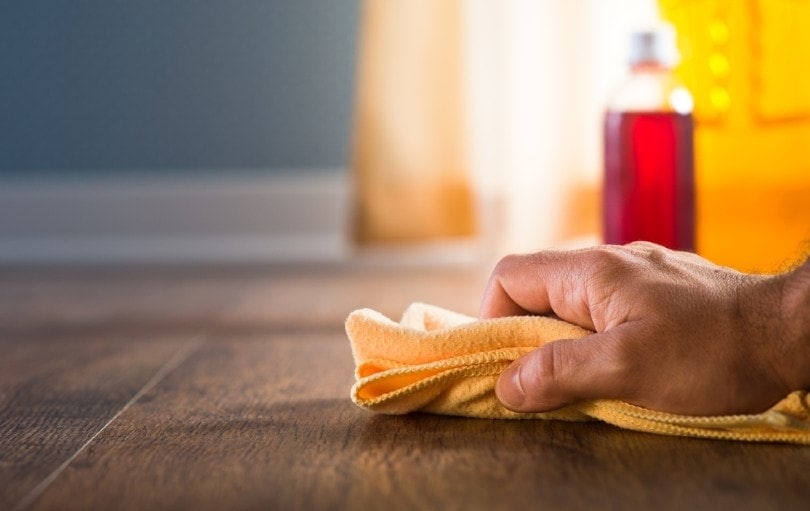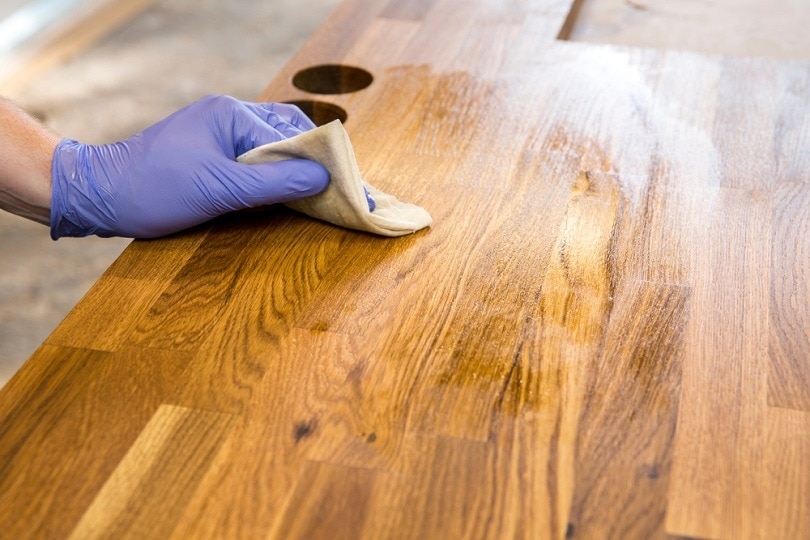Does WD-40 Remove Adhesive? Steps, Facts & FAQs
-
Kristin Hitchcock
- Last updated:

Imagine this: You’re peeling a price sticker off your new picture frame, and it tears so that you can’t get all that sticky, dust-collecting adhesive residue off the glass. You might wonder to yourself what your next steps are, and as you’re rooting through your cabinets, you discover a can of WD-40. But will it effectively remove your glue stain from your new frame? The short answer is… Yes!
WD-40 Multi-Use Product is a spray-on solution for most issues regarding rust or adhesives. It penetrates surface rust or glue to displace moisture and break its chemical bonds, allowing you to take care of these issues in minutes. It’s effective on wood, metal, plastics, and just about any other hard surface that will clean and protect.
How Do You Remove Adhesive with WD-40?
Removing adhesives with WD-40 is incredibly simple and only takes about 10 minutes. You’ll need a couple of cloths in addition to the can of WD-40. Once you have those items, follow our 3-step method to quickly and painlessly remove adhesive from most common surfaces.
The 3 Steps to Remove Adhesive From Surface
1. Wipe off your surface

Whether or not the adhesive has dried on your surface, it’s important to clean up as much as possible before going in with the big guns—or in this case, the big can. Wipe the surface with a disposable towel (if the adhesive is still wet) or a microfiber cloth to clear away any excess mess before spraying. This will make it easier for the WD-40 to penetrate the glue, allowing easy cleanup.
2. Spray WD-40 on your surface
It’s time to spray your surface. Coat the area with a generous spray of WD-40, concentrating only on the adhesive you’d like to remove. Allow the product to sit for 5 to 10 minutes, depending on the size and thickness of your adhesive. This will allow the WD-40 ample time to dissolve the bonds of your glue effectively without damaging the surface beneath it.
3. Wipe away excess product

Once your WD-40 has effectively penetrated your adhesive, it’s as simple as wiping away the product with a clean, damp cloth. It should wipe off without much effort but if you still experience resistance, you may need to re-spray and allow more time for the adhesives to dissolve.
There you have it! In about 10 minutes, your surface is glue-gunk free thanks to WD-40.
What Other Options Do I Have to Remove the Adhesive?
Not everyone has a can of WD-40 kicking around their house, or perhaps the product isn’t your favorite. There are many household remedies for removing adhesives in a pinch if that’s more your style:
- Nail Polish Remover: The acetone found in most nail polish removers dissolves most adhesives incredibly quickly. Soak a cotton ball or cloth in the liquid and hold it against the glue until it completely dissolves, then wipe.
- Hydrogen Peroxide: This one is particularly effective on superglue. Once again, soak a cotton ball with the product, holding it onto your adhesive until it melts away.
- Razor Blade: A razor-blade scraper may be enough to get the adhesive off of your glass, but be careful when using this method; if done improperly, you could scratch the surface or cut yourself with the blade.
Conclusion
Everyone gets into a sticky situation at least a few times in their lives—but armed with a can of WD-40, you’ll have that taken care of in no time. Soon enough, you’ll be back on the road to framing family portraits, having a glue-free craft table, or otherwise living your life without adhesives getting in your way.
Related Read:
- Does WD-40 Remove Hard Water Stains in Toilet? What You Need to Know!
- Best Microfiber Towels for Cars
Featured Image Credit: Benedek Alpar, Shutterstock
Contents

